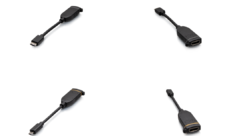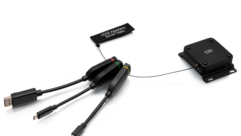

Inside HDMI’s New 3D Specs
In March, HDMI Licensing released HDMI 1.4a, which spelled out new 3D enhancements and requirements for broadcasting 3D content over HDMI. What do they mean for your next project? Here is a breakdown.
About this time last year, HDMI Licensing, which is responsible for publishing and promoting specifications for the High-Definition Multimedia Interface (HDMI), released HDMI version 1.4. At the time, the group alluded to upcoming enhancements in the spec that would promote 3D content, but it put off including mandatory 3D formats until the nascent market coalesced around preferred methods of delivering 3D. With 3D taking off as quickly as it has, that apparently took only nine months.
In March, HDMI Licensing released HDMI 1.4a, which spelled out new 3D enhancements and requirements for broadcasting 3D content over HDMI. Specifically, HDMI 1.4a mandates that 3D movie and game content be delivered in what is called frame-packed format (at 1080p resolution for movies or 720p for games), and broadcast 3D content be delivered in either side-by-side horizontal (1080i) or top-and-bottom (720p or 1080p) format.
What does it all mean for professional AV? Just as HDMI infiltrated commercial applications, HDMI-plus-3D will, too. That’s had companies in pro AV trying to make sense of the 3D standards in the HDMI 1.4a specification. Recently engineers at Digital Projection broke things down and came up with the following quick-hit descriptions:
Frame-packed 3D. This is the standard for 3D Blu-ray players now entering the market. Of the 3D standards in the HDMI 1.4a spec, frame-packed 3D delivers the highest native resolution from the source—true 1080p to each eye. Although the native frame rate of the source is only 24 frames per second (fps) per eye, triple-flash processing the signal, in which a projector repeats the process three times per frame using the same approach used in commercial cinemas, can produce a very good 3D experience. It’s also possible for 1280×720 native 3D to be delivered in a similar frame-packed format, but at 60 fps per eye. This could be used for 3D delivery where bandwidth is less than what Blu-ray offers.
Top-bottom 3D. This standard utilizes a 720p HD format, using the top 360 lines for left-eye content and the bottom 360 lines for right-eye content. The content for each eye is half the vertical resolution of a 720p signal (360 lines tall), but it’s the full 720p horizontal resolution (1280 pixels), captured at 60 fps. So although top-bottom provides the lowest native resolution from the source, it uses the highest native frame rate. A variant of the top-bottom standard could employ a 1080/24 format and dedicate 540 vertical lines and 1920 pixels of width to each of the left and right views at 24 fps.
Side-by-side 3D. Side-by-side 3D content comes in two flavors—progressive and interlaced. In the progressive version, left and right eye perspectives are packed side by side into each 1920×1080 frame. Each eye perspective is 960 pixels wide with 1080 lines of vertical resolution. Because the native horizontal resolution of each eye perspective is only 960 pixels wide, the scaling quality of the display device is critical.
When it comes to side-by-side interlaced 3D, the left and right eye perspectives are packed side-by-side into each of the odd line and even line fields of the video signal. Because each field only provides half of the 1080 vertical lines, in the native resolution of each eye is 960 pixels wide by 540 pixels high. The 1080i window used in the side-by-side interlaced format requires the display device to incorporate a high-quality de-interlacing circuit. Once de-interlacing is complete, the maximum vertical resolution can be presented from the source. And because the native horizontal resolution of each eye is only 960 pixels wide, the scaling quality of the display device is important.
Despite these caveats, side-by-side interlaced 3D looks to be the format most cable and satellite TV providers will use to deliver 3D content because of its balance between available bandwidth and maximum native resolution. Plan accordingly. Thanks to Digital Projection for its input.










